Nexus Between Artificial Intelligence, Renewable Energy, and Economic Development: A Multi-Method Approach
Abstract
1. Introduction
2. Literature Review
2.1. Correlation Between Renewable Energy (Production and Consumption) and AI
2.2. AI Investments and CO2 Emissions
2.2.1. The Role of AI in Reducing CO2 Emissions
2.2.2. AI Readiness Index and Development of AI-Related Projects
2.3. Correlation Between GDP per Capita, AI Investments, and Energy Transition
3. Materials and Methods
3.1. Dataset
3.1.1. Renewable Energy—Explained Variables
3.1.2. Artificial Intelligence—Explanatory Variables
3.1.3. Control Variables
3.2. Methodology
3.2.1. Robust Regression Analysis
- Yi = vector of the explained (dependent) variable for observation i;
- β0 = intercept;
- β1, β2, … β2 = regression coefficients;
- Xi1, Xi2, …Xin = explanatory (independent) variables for observation i;
- ε = errors;
- βXi = matrix of independent variables and regression coefficients.
- yi = dependent variable observed for the data point (observation) i;
- xTi = transpose of the vector of the explanatory variables for observation i;
- β = vector of the regression coefficients for which the estimation is made;
- p(ri) = loss function applied to residuals for observation i (ri = yi − xTi).
- X_std = standardization of variable X;
- μx = mean of variable X;
- σx = standard deviation of variable X.
3.2.2. Gaussian Graphical Model
- μ = mean vector;
- Ω = covariance matrix;
- ʘ = Ω-1 is the precision matrix, with Ɵi,j as an element, also known as the inverse of the covariance matrix.
3.2.3. Cluster Analysis Methodology
- deuc = Euclidean distance;
- x, y = vectors of a pair of two observations (the 30 countries included in the analysis);
- i = values for variable i;
- n = number of variables considered (the seven scientific variables described in Table 1).
- k = minimization function;
- s = number of variables;
- g = number of groups;
- r = object;
- yrsg = value of variable s, for object r, from group g;
- ng = number of objects in group g.
- d = distance between clusters;
- Ci,Cj = two distinct clusters;
- cen = center of a cluster, or centroid.
- xi = a point of cluster j (Cj);
- cenj = center of cluster j (Cj).
4. Results and Discussions
4.1. Robust Regression Models
- AI investments (AI_Inv) have a positive impact on both production and consumption of renewable energy but with different intensities.The Ln.RP–AI.Inv relationship is positive and highly statistically significant (p = 0.0006), where the coef. orig. = 1.102 shows that a one-unit increase in AI investments leads to a 110.2% increase in renewable energy production. The standardized coefficient = 0.269 confirms the substantial positive effect, suggesting that AI can facilitate the transition to renewable energy by offering solutions for the development of renewable energy production, along the same lines with Bennagi et al. (2024).The RC–AI.Inv relationship is positive, moderately statistically significant (p = 0.0114), and shows, through the coef. orig. = 12.84, that a one-unit increase in AI.Inv leads to an increase of 12.84 units in renewable energy consumption. The standardized coefficient = 0.448 confirms the moderate positive effect of AI.Inv on the RC (the fourth variable in terms of relative influence).From a practical perspective, these direct links suggest that AI investments are more effective in optimizing renewable energy production capacity than consumption. This differentiated impact is supported by Ahmad et al. (2021), who argued that AI’s role in energy transition operates through multiple technological channels. This aspect is normal in the initial stages of the energy transition process, as it is absolutely necessary to first expand production capacity, but, subsequently, AI investments are also required for the development and implementation of smart solutions for consumers.
- AI Readiness Score (AI_RS) generates a positive impact that is more significant on renewable energy consumption than on production.The relationship between the variables Ln.RP and AI.RS is positive but with very low statistical significance (p = 0.0525). The coef. orig. = 0.02838 shows that a one-unit increase in AI.RS can lead to a modest increase of 2.84% in renewable energy production.The standardized coefficient = 0.1418 shows that AI.RS is the variable with the least influence on Ln.RP, suggesting that it is not just a general commitment to AI that matters but rather concrete investments and specific projects for developing new solutions for obtaining energy from different renewable sources.The RC–AI.RS relationship is positive and highly statistically significant (p = 0.0001), showing an important effect of AI on renewable energy consumption (coef. orig. = +1.196 increase in the RC for one unit of AI.RS). The standardized coefficient = 0.8417 confirms the strong positive effect of AI.RS on RC (the second variable in terms of relative influence).From a practical perspective, the causal links demonstrate that the general commitment to AI has a greater potential to influence consumption behavior, possibly through optimizing energy distribution and increasing energy efficiency at the consumer level. This aligns with Oxford Insights’ (2024) Government AI Readiness Index framework and validates H.-J. Wang et al.’s (2025a) emphasis on institutional quality in renewable energy innovation.
- AI-related projects (AI.RP) generate a significant positive impact on renewable energy production, while the impact on renewable energy consumption is insignificant.The Ln.RP–AI.RP relationship is positive and highly statistically significant (p < 0.0001), showing that each AI project is important, leading to a 1.49% increase in renewable energy production (coef. orig. = 0.01485)—an aspect also confirmed by the std. coeff. = 0.2424.The RC–AI.RP relationship is negative (coef. orig. = −0.00391) but statistically insignificant (p = 0.956). The standardized coefficient = −0.0092 confirms that AI.RP is the variable with the least relative influence on RC.From a practical perspective, these statistical connections indicate that AI projects are more relevant for optimizing production than for managing renewable energy consumption, also suggesting that the impact on consumption may be indirect.
- CO2 emissions (Ln.CO) develop a complex relationship in the empirical analysis based on a positive link with renewable energy production and a negative link with renewable energy consumption:The relationship between Ln.RP and Ln.CO is positive and highly statistically significant (p < 0.0001), indicating contrary to expectations that renewable energy would result in zero emissions, a direct impact of increasing CO2 as a result of increasing green-energy production (+0.49%). This finding supports the temporal lag hypothesis discussed in Mirziyoyeva and Salahodjaev (2023) and extends Hao’s (2022) observations from China to our broader international context. Ln.CO is the variable with the highest relative importance in explaining renewable energy production (std. coef. = 0.542), an effect generated by the situation where countries with higher emissions are those with a high energy need and, although they tend to invest more in renewable energy, in the short term, the share in the energy mix remains dominant in favor of fossil fuels.The RC–Ln.CO relationship is negative (coef. orig. = −5.789), highly statistically significant (p < 0.001) and shows an inverse impact, important to be achieved, in the form of decreasing CO2 emissions as a result of increasing renewable energy consumption. This validates the consumption–emissions reduction pathway documented by Parmová et al. (2024) in Europe and Central Asia. The substantial relative RC-Ln.CO link (confirmed by the std. coef. of −0.9086, the highest level) corresponds to the energy transition process being implemented.From a practical perspective, the fact that CO2 emissions have opposite links with the production and consumption of renewable energy suggests more than a temporary gap between the development of effective renewable energy generation capacity and the greening of the energy system, corroborating the complex dynamics identified by Tatar and Aydin (2023) regarding CO2 regulations driving renewable capacity expansion. At the same time, it highlights that without a strategy to eliminate and not just complement fossil energy through renewables, along with measures to improve energy-consumption efficiency, the transition to climate neutrality will not be achieved.
- Gross domestic product per capita (GDP) develops negative relationships with both renewable energy production and renewable energy consumption but with different intensities.The Ln.RP–GDP relationship is negative and highly statistically significant (p < 0.0001), and it indicates an interesting inverse effect between the level of economic development of countries (GDP) and their ability to increase energy production from renewable sources. This finding challenges the linear positive relationship assumed in the economic development literature (OECD, 2024; Cozzi et al., 2024) and supports the “mature system constraints” hypothesis suggested by Ergun and Rivas (2023). Even if the size of this effect is small (coef. orig. = −0.00002141), GDP is a variable with high relative importance in the evolution of Ln.RP (std. coef. = −0.335). From a practical perspective, the negative relationship suggests that developed countries either already have mature and less flexible energy systems or have other dominant energy sources (nuclear and natural gas).The RC–GDP relationship is negative and statistically significant (p < 0.0001), and it indicates an inverse effect of a slightly higher intensity (coef. orig. = −0.0002932) between the level of economic development of countries (GDP) and the consumption of energy from renewable sources. These results align with Dissanayake et al.’s (2023) findings of inconsistent relationships between economic growth and renewable energy adoption across various development levels. The standardized coefficient = −0.6517 shows a medium relative importance of GDP in influencing the evolution of the RC. From a practical perspective, developed countries seem to be more resilient to energy transition, most likely due to their mature energy systems and infrastructure adapted to high consumption needs, coupled with the high costs involved in energy transition (especially in the industrial area).
- For the Ln_RP model (both original and standardized) (Figure 3 and Figure 4), the residuals vs. fitted graph shows the existence of a few (3) potentially influential observations, an aspect also confirmed by Cook’s distance; the normal Q–Q plot suggests a slight deviation from normality at the tails, while the scale–location plot indicates some heteroscedasticity;
- For the RC model (both original and standardized) (Figure 5 and Figure 6), the residuals vs. fitted graph indicates three observations as potentially problematic, with their presence also being confirmed by the scale–location and Cook’s distance, and the normal Q–Q plot shows a better alignment with the normal distribution compared to the Ln_RP model.
4.2. Gaussian Graphical Model
4.3. Cluster Analysis
5. Conclusions
Author Contributions
Funding
Institutional Review Board Statement
Informed Consent Statement
Data Availability Statement
Acknowledgments
Conflicts of Interest
References
- Acemoglu, D., & Restrepo, P. (2019). Automation and new tasks: How technology displaces and reinstates labor. Journal of Economic Perspectives, 33(2), 3–30. [Google Scholar] [CrossRef]
- Afjal, M. (2023). The tapestry of green economics: Mapping the nexus of CO2 emissions, economic growth, and renewable energy. International Journal of Sustainable Energy, 42(1), 1364–1390. [Google Scholar] [CrossRef]
- Agrawal, A., Gans, J., & Goldfarb, A. (2019). Economic policy for artificial intelligence. Innovation Policy and the Economy, 19(1), 139–159. [Google Scholar] [CrossRef]
- Agterberg, P., Hurink, J., La Poutré, H., Van de Vreede, G., de Weerdt, M., & Wilbrink, T. (2021). AI as an accelerator of the energy transition. Opportunities for a carbon-free energy system. Working Group Energy and Sustainability. Available online: https://nlaic.com/wp-content/uploads/2021/09/Position_paper_AI_as_an_accelerator_for_the_energy_transition.pdf (accessed on 15 March 2025).
- Ahmad, T., Zhang, D., Huang, C., Zhang, H., Dai, N., Song, Y., & Chen, H. (2021). Artificial intelligence in sustainable energy industry: Status Quo, challenges and opportunities. Journal of Cleaner Production, 289, 125834. [Google Scholar] [CrossRef]
- Alotaiq, A. (2024). Global low carbon transitions in the power sector: A machine learning clustering approach using archetypes. Journal of Economy and Technology, 2, 95–127. [Google Scholar] [CrossRef]
- Alsaigh, R., Mehmood, R., & Katib, I. (2022). AI explainability and governance in smart energy systems: A review. arXiv, arXiv:2211.00069. [Google Scholar] [CrossRef]
- Andersen, R. (2008). Modern methods for robust regression. SAGE Publications, Inc. [Google Scholar] [CrossRef]
- Attanayake, K., Wickramage, I., Samarasinghe, U., Ranmini, Y., Ehalapitiya, S., Jayathilaka, R., & Yapa, S. (2024). Renewable energy as a solution to climate change: Insights from a comprehensive study across nations. PLoS ONE, 19(6), e0299807. [Google Scholar] [CrossRef]
- Bennagi, A., AlHousrya, O., Cotfas, D. T., & Cotfas, P. A. (2024). Comprehensive study of the artificial intelligence applied in renewable energy. Energy Strategy Reviews, 54, 101446. [Google Scholar] [CrossRef]
- Bishaw, F. G. (2024). Review artificial intelligence applications in renewable energy systems integration. Journal of Electrical Systems, 20(3), 3. [Google Scholar] [CrossRef]
- Biswas, P., Rashid, A., Biswas, A., Nasim, M. A. A., Gupta, K. D., & George, R. (2024). AI-driven approaches for optimizing power consumption: A comprehensive survey. arXiv, arXiv:2406.15732. [Google Scholar] [CrossRef]
- Budennyy, S., Lazarev, V., Zakharenko, N., Korovin, A., Plosskaya, O., Dimitrov, D., Arkhipkin, V., Oseledets, I., Barsola, I., Egorov, I., Kosterina, A., & Zhukov, L. (2022). ECO2AI: Carbon emissions tracking of machine learning models as the first step towards sustainable AI. arXiv, arXiv:2208.00406. [Google Scholar] [CrossRef]
- Budiraharjo, M. H., Muhammad, A. H., & Kusnawi. (2024). MSME AI readiness analysis using the AIRI framework. Jurnal Teknologi Informasi Universitas Lambung Mangkurat (JTIULM), 9(2), 2. [Google Scholar] [CrossRef]
- Caldera, Y., Ranthilake, T., Gunawardana, H., Senevirathna, D., Jayathilaka, R., Rathnayake, N., & Peter, S. (2024). Understanding the interplay of GDP, renewable, and non-renewable energy on carbon emissions: Global wavelet coherence and Granger causality analysis. PLoS ONE, 19(9), e0308780. [Google Scholar] [CrossRef] [PubMed]
- Carlsson, B., & Stankiewicz, R. (1991). On the nature, function and composition of technological systems. Journal of Evolutionary Economics, 1, 93–11. [Google Scholar] [CrossRef]
- Castro, D., McLaughlin, M., & Chivot, E. (2019, August 19). Who is winning the AI race: China, the EU or the United States? Center for Data Innovation. Available online: https://datainnovation.org/2019/08/who-is-winning-the-ai-race-china-the-eu-or-the-united-states/ (accessed on 15 February 2025).
- Chen, L., Chen, Z., Zhang, Y., Liu, Y., Osman, A. I., Farghali, M., Hua, J., Al-Fatesh, A., Ihara, I., Rooney, D. W., & Yap, P.-S. (2023). Artificial intelligence-based solutions for climate change: A review. Environmental Chemistry Letters, 21(5), 2525–2557. [Google Scholar] [CrossRef]
- Chiekezie, N. R., Obiki-Osafiele, A. N., & Agu, E. E. (2024). Preparing the workforce for AI technologies through training and professional development for future readiness. World Journal of Engineering and Technology Research, 3(1), 001–018. [Google Scholar] [CrossRef]
- Chishti, M. Z., Xia, X., & Dogan, E. (2024). Understanding the effects of artificial intelligence on energy transition: The moderating role of Paris Agreement. Energy Economics, 131, 107388. [Google Scholar] [CrossRef]
- Cisco. (n.d.). Cisco AI readiness index—Cisco. Available online: https://www.cisco.com/c/m/en_us/solutions/ai/readiness-index.html (accessed on 4 February 2025).
- Cozzi, L., Gul, T., Spencer, T., & Lever, P. (2024, April 18). Clean energy is boosting economic growth—Analysis. IEA. Available online: https://www.iea.org/commentaries/clean-energy-is-boosting-economic-growth (accessed on 16 March 2025).
- Danish, M. S. S., & Senjyu, T. (2023). AI-enabled energy policy for a sustainable future. Sustainability, 15(9), 7643. [Google Scholar] [CrossRef]
- Dellosa, J. T., & Palconit, E. C. (2021, September 7–10). Artificial Intelligence (AI) in renewable energy systems: A condensed review of its applications and techniques. 2021 IEEE International Conference on Environment and Electrical Engineering and 2021 IEEE Industrial and Commercial Power Systems Europe (EEEIC/I&CPS Europe) (pp. 1–6), Bari, Italy. [Google Scholar] [CrossRef]
- Dissanayake, H., Perera, N., Abeykoon, S., Samson, D., Jayathilaka, R., Jayasinghe, M., & Yapa, S. (2023). Nexus between carbon emissions, energy consumption, and economic growth: Evidence from global economies. PLoS ONE, 18(6), e0287579. [Google Scholar] [CrossRef]
- Doğan, B., Tiwari, S., Bergougui, B., Ghosh, S., & Balsalobre-Lorente, D. (2025). Green innovation and fiscal spending: Decoding the path to sustainable development. Sustainable Development, 33(4), 6307–6327. [Google Scholar] [CrossRef]
- Dong, Z., Tan, C., Ma, B., & Ning, Z. (2024). The impact of artificial intelligence on the energy transition: The role of regulatory quality as a guardrail, not a wall. Energy Economics, 140, 107988. [Google Scholar] [CrossRef]
- Elkington, J. (1997). Cannibals with forks: The triple bottom line of 21st century business. Capstone. [Google Scholar]
- Epskamp, S., & Fried, E. I. (2018). A tutorial on regularized partial correlation networks. Psychological Methods, 23(4), 617–634. [Google Scholar] [CrossRef]
- Ergun, S. J., & Rivas, M. F. (2023). Does higher income lead to more renewable energy consumption? Evidence from emerging-Asian countries. Heliyon, 9(1), e13049. [Google Scholar] [CrossRef]
- European Commission (EC). (2018). Artificial intelligence for Europe. European Commission (EC). Available online: https://eur-lex.europa.eu/legal-content/EN/TXT/PDF/?uri=CELEX:52018DC0237 (accessed on 10 March 2025).
- European Commission (EC). (2019). The European green deal. Communication from the Commission to the European Parliament, the European Council, the Council, the European Economic and Social Committee and the Committee of the Regions. European Commission (EC). Available online: https://eur-lex.europa.eu/resource.html?uri=cellar:b828d165-1c22-11ea-8c1f-01aa75ed71a1.0002.02/DOC_1&format=PDF (accessed on 20 March 2025).
- European Parliament (EP). (2018, August 3). Reducing carbon emissions: EU targets and policies. European Parliament. Available online: https://www.europarl.europa.eu/topics/en/article/20180305STO99003/reducing-carbon-emissions-eu-targets-and-policies (accessed on 21 March 2025).
- European Parliament (EP). (2024, February 29). Renewable energy|Fact Sheets on the European Union|European Parliament. Available online: https://www.europarl.europa.eu/factsheets/en/sheet/70/energia-din-surse-regenerabile (accessed on 15 March 2025).
- European Union. (2021). Regulation (EU) 2021/1119 of the European parliament and of the council of 30 June 2021 establishing the framework for achieving climate neutrality and amending regulations (EC) No 401/2009 and (EU) 2018/1999 (‘European climate law’). 243 OJ L. Available online: http://data.europa.eu/eli/reg/2021/1119/oj/eng (accessed on 2 February 2025).
- European Union. (2024). Regulation (EU) 2024/1689 of the European parliament and of the council of 13 June 2024 laying down harmonised rules on artificial intelligence and amending regulations (EC) No 300/2008, (EU) No 167/2013, (EU) No 168/2013, (EU) 2018/858, (EU) 2018/1139 and (EU) 2019/2144 and directives 2014/90/EU, (EU) 2016/797 and (EU) 2020/1828 (artificial intelligence act) text with EEA relevance. Pub. L. No. 2024/1689. Available online: https://eur-lex.europa.eu/legal-content/EN/TXT/PDF/?uri=OJ:L_202401689 (accessed on 4 February 2025).
- Fang, Y., Lee, C.-C., & Li, X. (2025). Assessing the impact of artificial intelligence on the transition to renewable energy? Analysis of U.S. states under policy uncertainty. Renewable Energy, 246, 122969. [Google Scholar] [CrossRef]
- Fox, J., & Weisberg, S. (2018). Robust regression in R, an appendix to an R companion to applied regression. In An R companion to applied regression (3rd ed.). SAGE Publications. [Google Scholar]
- Fraisl, D., See, L., Fritz, S., Haklay, M., & McCallum, I. (2025). Leveraging the collaborative power of AI and citizen science for sustainable development. Nature Sustainability, 8(2), 125–132. [Google Scholar] [CrossRef]
- Friedlingstein, P., O’Sullivan, M., Jones, M. W., Andrew, R. M., Bakker, D. C. E., Hauck, J., Landschützer, P., Le Quéré, C., Luijkx, I. T., Peters, G. P., Peters, W., Pongratz, J., Schwingshackl, C., Sitch, S., Canadell, J. G., Ciais, P., Jackson, R. B., Alin, S. R., Anthoni, P., … Zheng, B. (2023). Global carbon budget 2023. Earth System Science Data, 15(12), 5301–5369. [Google Scholar] [CrossRef]
- Furman, J., & Seamans, R. (2018). AI and the economy (SSRN scholarly paper No. 3186591). Social Science Research Network. [Google Scholar] [CrossRef]
- Garric, A., & Piquard, A. (2024, August 4). Les promesses de l’IA grevées par un lourd bilan carbone. Le Monde. Available online: https://www.lemonde.fr/planete/article/2024/08/04/climat-les-promesses-de-l-ia-grevees-par-un-lourd-bilan-carbone_6266586_3244.html (accessed on 5 March 2025).
- Gondauri, D., Batiashvili, M., & Enukidze, N. (2024). Deciphering the AI economy: A mathematical model perspective. International Journal of Business and Management, 19(3), 3. [Google Scholar] [CrossRef]
- HAI. (2018). Artificial intelligence index report 2024. Available online: https://hai.stanford.edu/ai-index (accessed on 25 February 2025).
- Hao, Y. (2022). The relationship between renewable energy consumption, carbon emissions, output, and export in industrial and agricultural sectors: Evidence from China. Environmental Science and Pollution Research, 29(42), 63081–63098. [Google Scholar] [CrossRef]
- Hevey, D. (2018). Network analysis: A brief overview and tutorial. Health Psychology and Behavioral Medicine, 6(1), 301–328. [Google Scholar] [CrossRef]
- im Walde, S. S. (2006). Experiments on the automatic induction of German semantic verb classes. Computational Linguistics, 32(2), 159–194. [Google Scholar] [CrossRef]
- Intergovernmental Panel on Climate Change (IPCC). (2023). Climate change 2023: Synthesis report (Core Writing Team, H. Lee, & J. Romero, Eds.; pp. 35–115). Contribution of Working Groups I, II and III to the Sixth Assessment Report of the Intergovernmental Panel on Climate Change. IPCC. [Google Scholar]
- International Energy Agency (IEA). (2021, August 6). Better energy efficiency policy with digital tools—Analysis. Available online: https://www.iea.org/articles/better-energy-efficiency-policy-with-digital-tools (accessed on 11 March 2025).
- International Energy Agency (IEA). (2024a). Renewables 2024—Analysis—IEA. Available online: https://www.iea.org/reports/renewables-2024 (accessed on 10 March 2025).
- International Energy Agency (IEA). (2024b, October 16). World energy outlook 2024—Analysis. Available online: https://www.iea.org/reports/world-energy-outlook-2024 (accessed on 12 March 2025).
- International Monetary Fund (IMF). (n.d.). AI preparedness index (AIPI). Available online: https://www.imf.org/external/datamapper/datasets/AIPI (accessed on 6 February 2025).
- Iqbal, S., Wang, Y., Shaikh, P. A., Maqbool, A., & Hayat, K. (2022). Exploring the asymmetric effects of renewable energy production, natural resources, and economic progress on CO2 emissions: Fresh evidence from Pakistan. Environmental Science and Pollution Research, 29(5), 7067–7078. [Google Scholar] [CrossRef]
- Issa, D. H., Jabbouri, D. R., & Palmer, M. (2021). An artificial intelligence (AI)-readiness and adoption framework for agritech firms (SSRN scholarly paper No. 3971188). Social Science Research Network. [Google Scholar] [CrossRef]
- Jamison, S., Moussavi, B., Macchi, M., & Bermudez, M. (2024). Companies are decarbonizing. But how can they go faster? (Destination net zero). Accenture. Available online: https://www.accenture.com/content/dam/accenture/final/accenture-com/document-3/Accenture-Destination-Net-Zero-Final-Report.pdf (accessed on 12 March 2025).
- Kassambara, A. (2017). Practical guide to cluster analysis in R. STHDA. Available online: https://xsliulab.github.io/Workshop/2021/week10/r-cluster-book.pdf (accessed on 7 February 2025).
- KPMG. (n.d.). Energy institute statistical review of world energy 2024. Available online: https://assets.kpmg.com/content/dam/kpmg/nl/pdf/2023/services/statistical-review-of-world-energy-kleiner.pdf (accessed on 16 February 2025).
- Kyriakarakos, G. (2025). Artificial intelligence and the energy transition. Sustainability, 17(3), 1140. [Google Scholar] [CrossRef]
- Lampropoulos, G., Garzón, J., Misra, S., & Siakas, K. (2024). The role of artificial intelligence of things in achieving sustainable development goals: State of the art. Sensors, 24(4), 1091. [Google Scholar] [CrossRef]
- Lundvall, B.-Å. (Ed.). (1992). National systems of innovation: Toward a theory of innovation and interactive learning. Anthem Press. Available online: http://www.jstor.org/stable/j.ctt1gxp7cs (accessed on 16 February 2025).
- Maechler, M., Rousseeuw, P., Croux, C., Todorov, V., Ruckstuhl, A., Salibian-Barrera, M., Verbeke, T., Koller, M., Conceicao, E. L. T., & di Palma, M. A. (2024). robustbase: Basic robust statistics (Version 0.99-4-1) [Computer software]. Available online: https://cran.r-project.org/web/packages/robustbase/index.html (accessed on 20 February 2025).
- Maronna, R. A., Martin, R. D., Yohai, V. J., & Salibián-Barrera, M. (2018). Robust statistics: Theory and methods (with R). John Wiley & Sons Ltd. [Google Scholar]
- McKinsey. (2024). Global energy perspective. Available online: https://www.mckinsey.com/industries/energy-and-materials/our-insights/global-energy-perspective (accessed on 17 February 2025).
- Mecu, A.-N., Chitu, F., Marin, G.-I., & Hurduzeu, G. (2023). Analysis of the Impact of Energy Efficiency and Renewable Energy on Greenho use Gas Emissions and Economic Growth in EU Member States. Amfiteatru Economic, 25(Special 17), 1149. [Google Scholar] [CrossRef]
- Menai, I., Salah, H. S., Khelil, S., Aidaoui, A., & Djouad, F. Z. (2024, May 23–24). The transition to artificial intelligence-based solutions for improving energy efficiency in urban environments. International Conference of Contemporary Affairs in Architecture and Urbanism-ICCAUA (Vol. 7, p. 1), Alanya, Turkey. [Google Scholar] [CrossRef]
- Mirziyoyeva, Z., & Salahodjaev, R. (2023). Renewable energy, GDP and CO2 emissions in high-globalized countries. Frontiers in Energy Research, 11, 1123269. [Google Scholar] [CrossRef]
- Nasir, O., Javed, R. T., Gupta, S., Vinuesa, R., & Qadir, J. (2023). Artificial intelligence and sustainable development goals nexus via four vantage points. Technology in Society, 72, 102171. [Google Scholar] [CrossRef]
- Nature Energy. (2024, January 29). Folosirea inteligentei artificiale în domeniul energiilor verzi. Available online: https://www.naturenergy.ro/2024/01/29/folosirea-inteligentei-artificiale-in-domeniul-energiilor-verzi/ (accessed on 9 March 2025).
- Noorman, M., Espinosa Apráez, B., & Lavrijssen, S. (2023). AI and energy justice. Energies, 16(5), 2110. [Google Scholar] [CrossRef]
- North, D. C. (1990). Institutions, institutional change and economic performance. Cambridge University Press. [Google Scholar]
- OECD. (n.d.). Live data from OECD.AI. Available online: https://oecd.ai/en/data (accessed on 10 February 2025).
- OECD. (2024). Nominal gross domestic product (GDP). OECD. Available online: https://www.oecd.org/en/data/indicators/nominal-gross-domestic-product-gdp.html (accessed on 9 March 2025).
- Olatunde, T. M., Okwandu, A. C., Akande, D. O., & Sikhakhane, Z. Q. (2024). Reviewing the role of artificial intelligence in energy efficiency optimization. Engineering Science & Technology Journal, 5(4), 1243–1256. [Google Scholar] [CrossRef]
- Onwusinkwue, S., Osasona, F., Ahmad, I. A. I., Anyanwu, A. C., Dawodu, S. O., Obi, O. C., & Hamdan, A. (2024). Artificial intelligence (AI) in renewable energy: A review of predictive maintenance and energy optimization. World Journal of Advanced Research and Reviews, 21(1), 2487–2499. [Google Scholar] [CrossRef]
- Oukaira, A., Karime, A., Roberge, V., & Tarbouchi, M. (2024, July 29–31). Toward increased energy efficiency and proactive management of electrical grids based on AI. 2024 International Conference on Computing, Internet of Things and Microwave Systems (ICCIMS) (pp. 1–4), Gatineau, QC, Canada. [Google Scholar] [CrossRef]
- Oxford Insights. (2024). 2024 government AI readiness index. Oxford Insights. Available online: https://oxfordinsights.com/ai-readiness/ai-readiness-index/ (accessed on 13 March 2025).
- Parmová, D. S., Teshabaev, T., Kasimova, N., & Salahodjaev, R. (2024). Mitigating CO2 emissions: The synergy of foreign direct investment and renewable energy in Europe and central Asia. International Journal of Energy Economics and Policy, 14(1), 620–627. [Google Scholar] [CrossRef]
- Pasqualetto, A., Serafini, L., & Sprocatti, M. (2024). Artificial intelligence approaches for energy efficiency: A review. arXiv, arXiv:2407.21726. [Google Scholar] [CrossRef]
- Pata, U. K., Kartal, M. T., & Kılıç Depren, S. (2024). The role of information and communication technologies and energy-related research and development investments in energy transition: Evidence from the united states of America by machine learning algorithm. Energy Technology, 12(5), 2301199. [Google Scholar] [CrossRef]
- Pimenow, S., Pimenowa, O., & Prus, P. (2024). Challenges of artificial intelligence development in the context of energy consumption and impact on climate change. Energies, 17(23), 5965. [Google Scholar] [CrossRef]
- Rane, N. L., Choudhary, S. P., & Rane, J. (2024). Artificial intelligence and machine learning in renewable and sustainable energy strategies: A critical review and future perspectives. Partners Universal International Innovation Journal, 2(3), 80–102. [Google Scholar] [CrossRef]
- Rashid, A., Biswas, P., Biswas, A., Nasim, M. A. A., Gupta, K. D., & George, R. (2024). Present and future of AI in renewable energy domain: A comprehensive survey. arXiv, arXiv:2406.16965. [Google Scholar] [CrossRef]
- Rinchi, O., Alsharoa, A., Shatnawi, I., & Arora, A. (2024). The role of intelligent transportation systems and artificial intelligence in energy efficiency and emission reduction. arXiv, arXiv:2401.14560. [Google Scholar] [CrossRef]
- Rojek, I., Mroziński, A., Kotlarz, P., Macko, M., & Mikołajewski, D. (2023). AI-based computational model in sustainable transformation of energy markets. Energies, 16(24), 8059. [Google Scholar] [CrossRef]
- Rusilowati, U., Ngemba, H. R., Anugrah, R. W., Fitriani, A., & Astuti, E. D. (2024). Leveraging AI for superior efficiency in energy use and development of renewable resources such as solar energy, wind, and bioenergy. International Transactions on Artificial Intelligence, 2(2), 114–120. [Google Scholar] [CrossRef]
- Scott, W. R. (2014). Institutions and organizations: Ideas, interests, and identities (4th ed.). Sage Publishing. [Google Scholar]
- Sheng, T., Li, B., & Solea, E. (2023). On skewed Gaussian graphical models. Journal of Multivariate Analysis, 194, 105129. [Google Scholar] [CrossRef]
- Shonhe, L. (2024). Conceptual framework to explore artificial intelligence technology (AIT) readiness and adoption intention in records and information management (RIM) practices: A proposal. Records Management Journal, 35(1), 18–34. [Google Scholar] [CrossRef]
- Singh, A., Kanaujia, A., Singh, V. K., & Vinuesa, R. (2024). Artificial intelligence for Sustainable Development Goals: Bibliometric patterns and concept evolution trajectories. Sustainable Development, 32(1), 724–754. [Google Scholar] [CrossRef]
- Statista. (2023). Global AI market size 2030. Statista. Available online: https://www.statista.com/statistics/1365145/artificial-intelligence-market-size/#:~:text=Global%20artificial%20intelligence%20market%20size%202021%2D2030&text=Its%20value%20of%20nearly%20100,a%20vast%20number%20of%20industries (accessed on 6 February 2025).
- Tatar, S. M., & Aydin, E. (2023). Design and operation of renewable energy microgrids under uncertainty towards green deal and minimum carbon emissions. arXiv, arXiv:2304.14709. [Google Scholar] [CrossRef]
- Tran, B.-L., Chen, C.-C., & Tseng, W.-C. (2022). Causality between energy consumption and economic growth in the presence of GDP threshold effect: Evidence from OECD countries. Energy, 251, 123902. [Google Scholar] [CrossRef]
- Tsai, K., Koyejo, O., & Kolar, M. (2022). Joint Gaussian graphical model estimation: A survey. WIREs Computational Statistics, 14(6), e1582. [Google Scholar] [CrossRef]
- Tudora, E., Tîrziu, E., & Gheorghe-Moisii, M. (2021). Internet of things în energie: Tehnologii, aplicații, provocări și tendințe viitoare. Revista Română de Informatică și Automatică, 31(2), 45–58. [Google Scholar] [CrossRef]
- United Nations (UN). (2015a). Paris agreement. Available online: https://unfccc.int/sites/default/files/english_paris_agreement.pdf (accessed on 5 March 2025).
- United Nations (UN). (2015b). Take action for the sustainable development goals. Available online: https://www.un.org/sustainabledevelopment/sustainable-development-goals/ (accessed on 9 March 2025).
- United Nations (UN). (2024). Govering AI for humanity: Final report. United Nations. Available online: https://www.un.org/sites/un2.un.org/files/governing_ai_for_humanity_final_report_en.pdf (accessed on 12 March 2025).
- Verdecchia, R., Sallou, J., & Cruz, L. (2023). A systematic review of green AI. arXiv, arXiv:2301.11047. [Google Scholar] [CrossRef]
- Vinuesa, R., Azizpour, H., Leite, I., Balaam, M., Dignum, V., Domisch, S., Felländer, A., Langhans, S. D., Tegmark, M., & Fuso Nerini, F. (2020). The role of artificial intelligence in achieving the Sustainable Development Goals. Nature Communications, 11(1), 233. [Google Scholar] [CrossRef]
- Vîrjan, D., Popescu, C. R., Pop, I., & Popescu. (2023). Energy transition and sustainable development at the level of the European Union. Amfiteatru Economic, 25(63), 429. [Google Scholar] [CrossRef]
- Wang, H.-J., Jin, S.-L., & Chang, C.-P. (2025a). Does artificial intelligence bring to renewable energy innovation? Yes, empirical investigation for 51 countries? International Journal of Green Energy, 22(2), 375–390. [Google Scholar] [CrossRef]
- Wang, Q., Li, Y., & Li, R. (2024). Ecological footprints, carbon emissions, and energy transitions: The impact of artificial intelligence (AI). Humanities and Social Sciences Communications, 11(1), 1–18. [Google Scholar] [CrossRef]
- Wang, Q., Sun, T., & Li, R. (2025b). Does artificial intelligence (AI) enhance green economy efficiency? The role of green finance, trade openness, and R&D investment. Humanities and Social Sciences Communications, 12(1), 1–22. [Google Scholar] [CrossRef]
- Ward, J. H., & Hook, M. E. (1963). Application of an hierarchical grouping procedure to a problem of grouping profiles. Educational and Psychological Measurement, 23(1), 69–81. [Google Scholar] [CrossRef]
- World Commission on Environment and Development. (1987). Report of the world commission on environment and development: Our common future. United Nations. Available online: https://sustainabledevelopment.un.org/content/documents/5987our-common-future.pdf (accessed on 20 August 2025).
- World Economic Forum. (2024, July 22). AI and energy: Will AI reduce emissions or increase power demand? World Economic Forum. Available online: https://www.weforum.org/stories/2024/07/generative-ai-energy-emissions/ (accessed on 14 March 2025).
- Yan, S., Shah, M. H., Li, J., O’Connor, N., & Liu, M. (2023, October 27–29). A review on AI algorithms for energy management in e-mobility services. 7th CAA International Conference on Vehicular Control and Intelligence (CVCI) (pp. 1–8), Changsha, China. [Google Scholar] [CrossRef]
- Zhang, C., Xia, Q., & Yang, G. (2015, June 15–17). Reconsideration about clustering analysis. IEEE 10th Conference on Industrial Electronics and Applications (ICIEA) (pp. 1517–1524), Auckland, New Zealand. [Google Scholar] [CrossRef]
- Zhao, C., Dong, K., Wang, K., & Nepal, R. (2024). How does artificial intelligence promote renewable energy development? The role of climate finance. Energy Economics, 133, 107493. [Google Scholar] [CrossRef]
- Zhao, Q., Wang, L., Stan, S.-E., & Mirza, N. (2024). Can artificial intelligence help accelerate the transition to renewable energy? Energy Economics, 134, 107584. [Google Scholar] [CrossRef]
- Zheng, H., Wu, J., Li, R., & Song, Y. (2025). The role of artificial intelligence in renewable energy development: Insights from less developed economies. Energy Economics 146, 108551. [Google Scholar] [CrossRef]
- Zhong, J., Zhong, Y., Han, M., Yang, T., & Zhang, Q. (2024). The impact of AI on carbon emissions: Evidence from 66 countries. Applied Economics, 56(25), 2975–2989. [Google Scholar] [CrossRef]
- Zoccolotti, P., Angelelli, P., Marinelli, C. V., & Romano, D. L. (2021). A Network Analysis of the Relationship among Reading, Spelling and Maths Skills. Brain Sciences, 11(5), 656. [Google Scholar] [CrossRef]

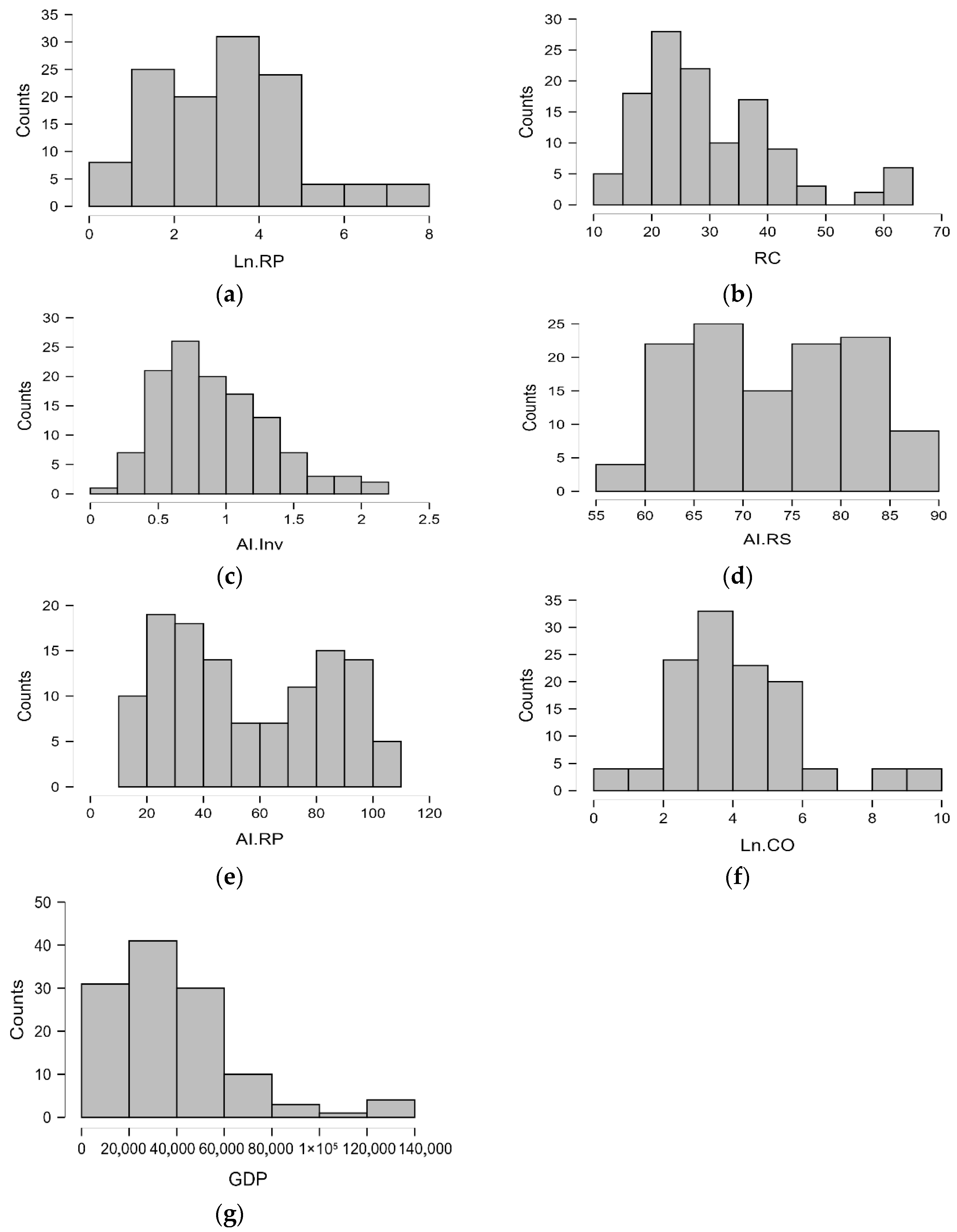

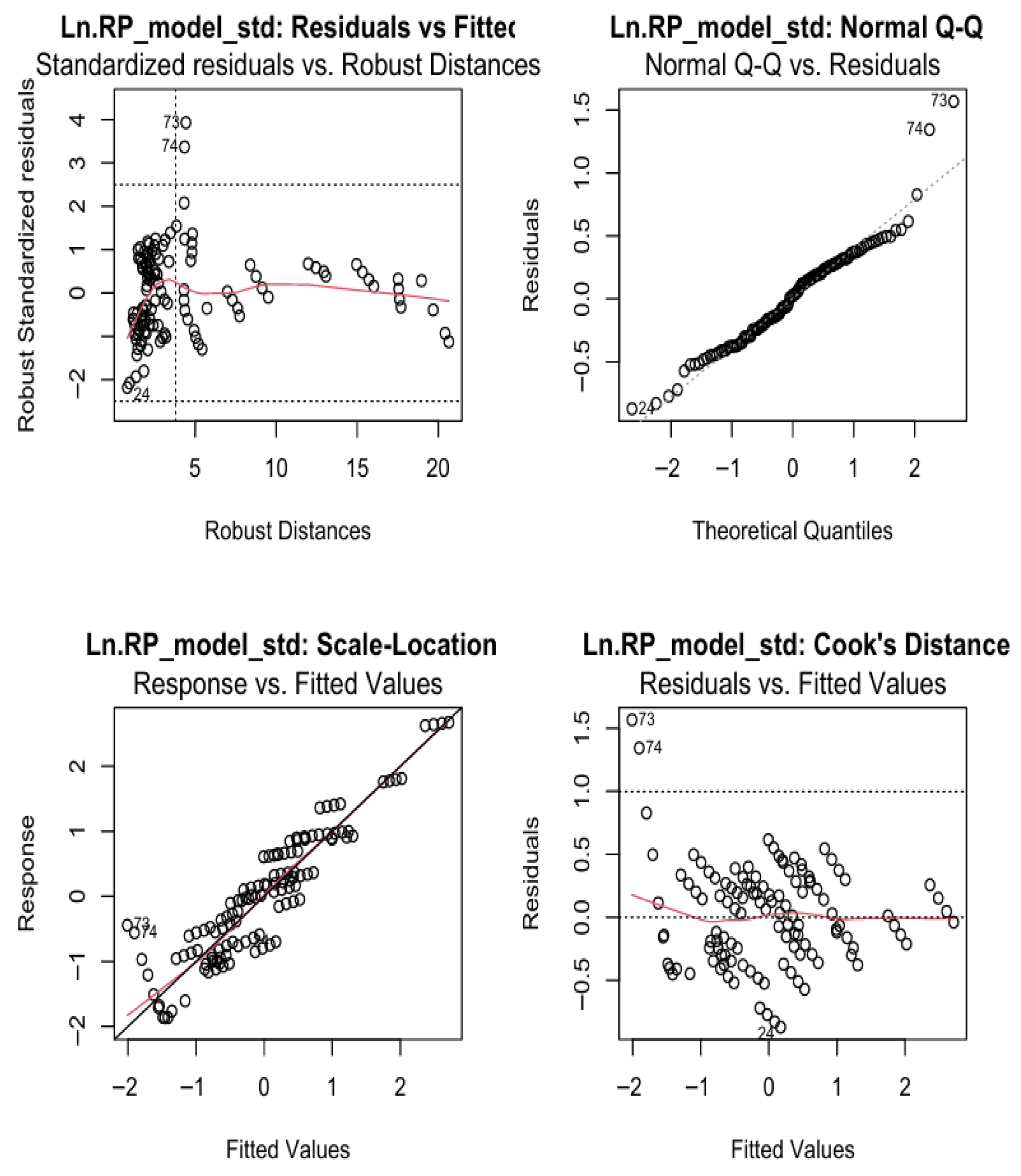
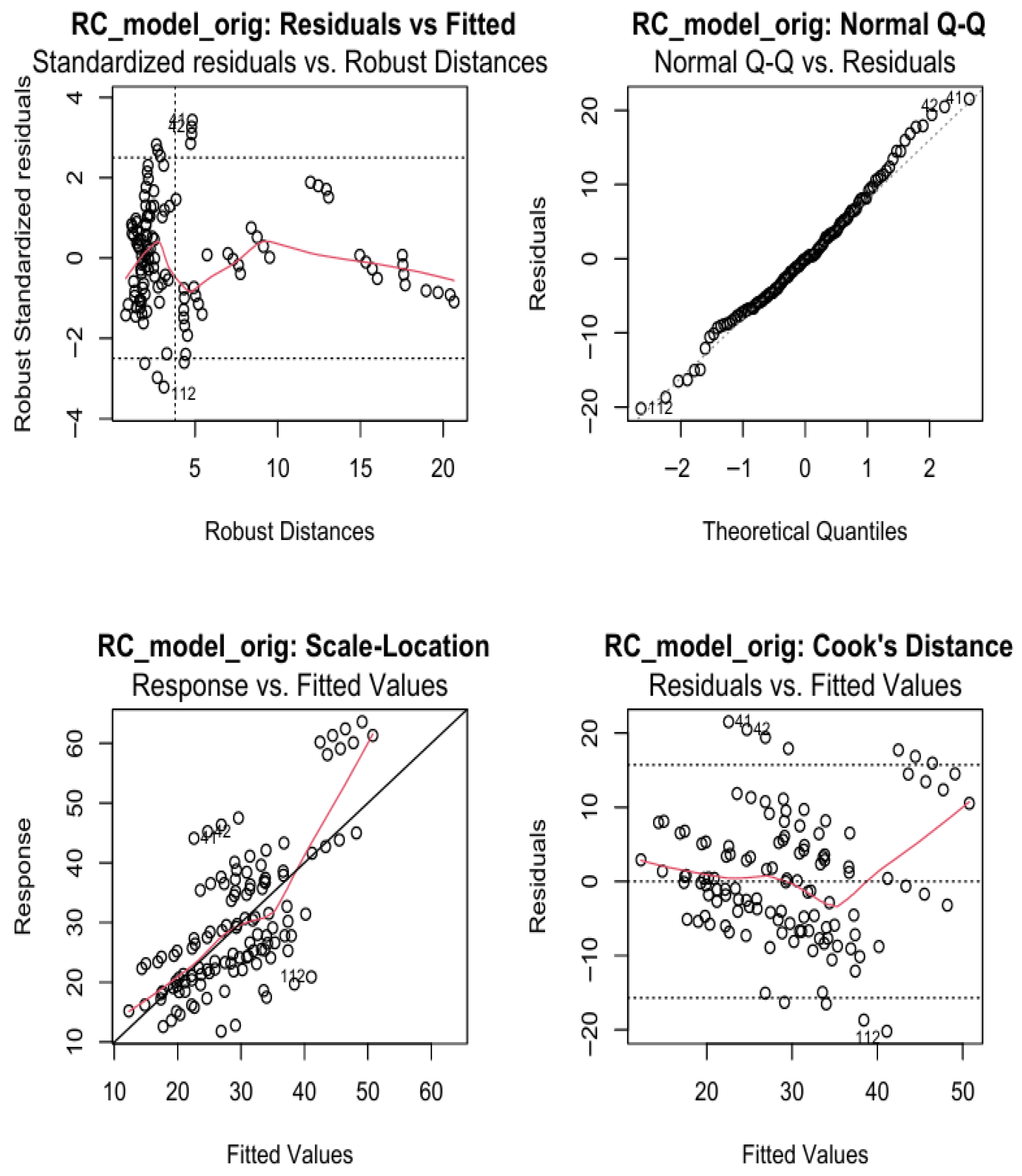
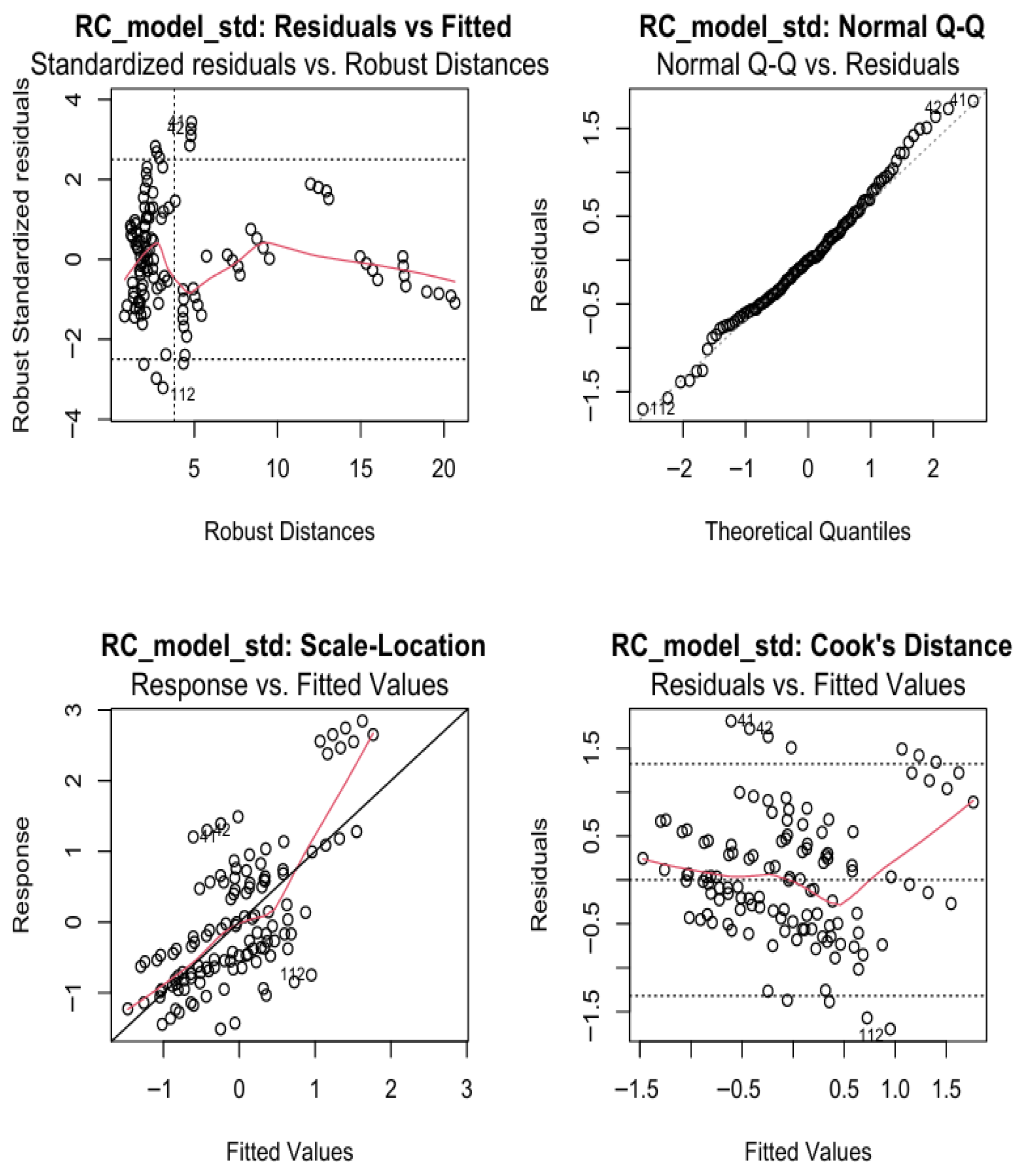

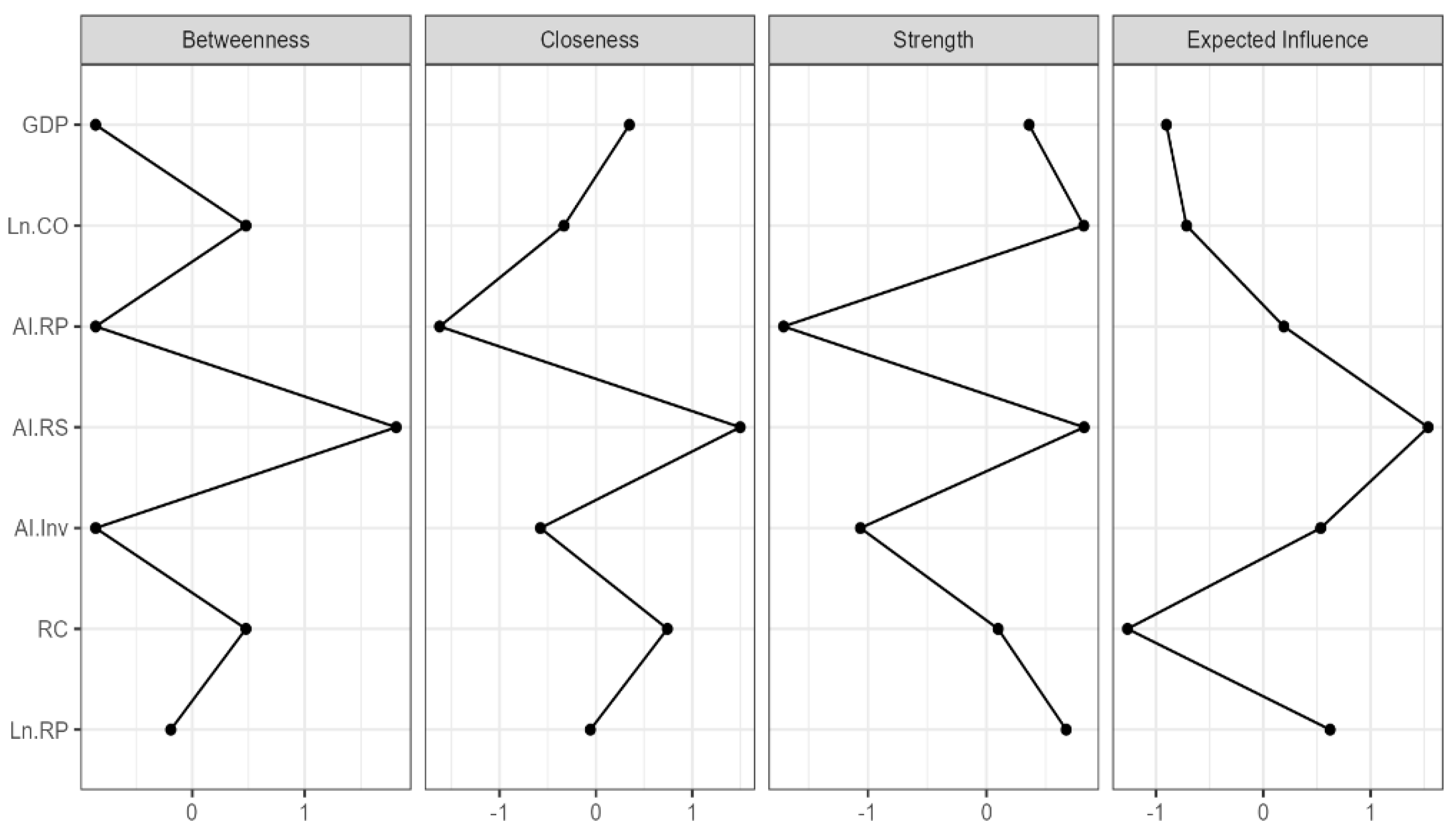
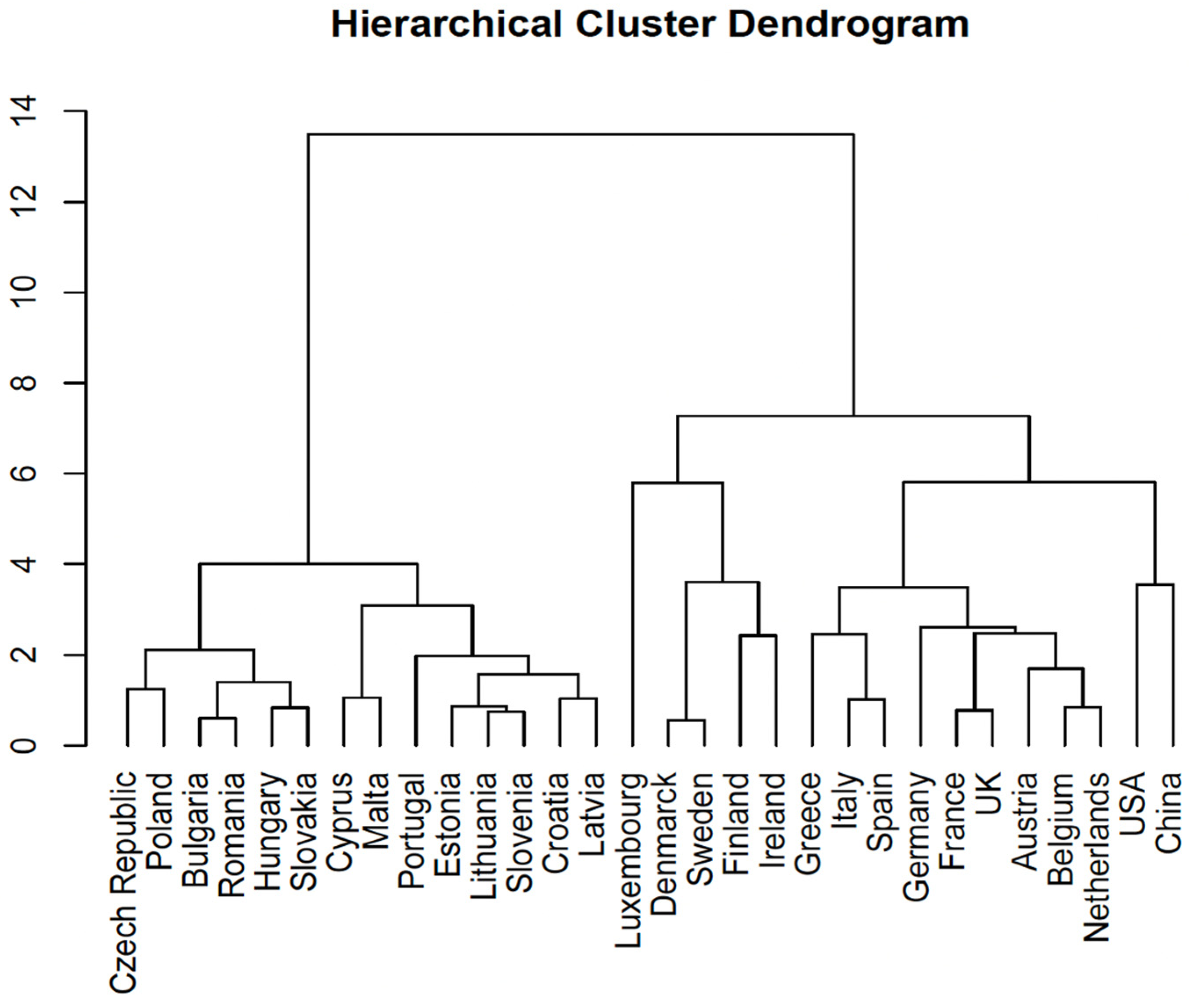
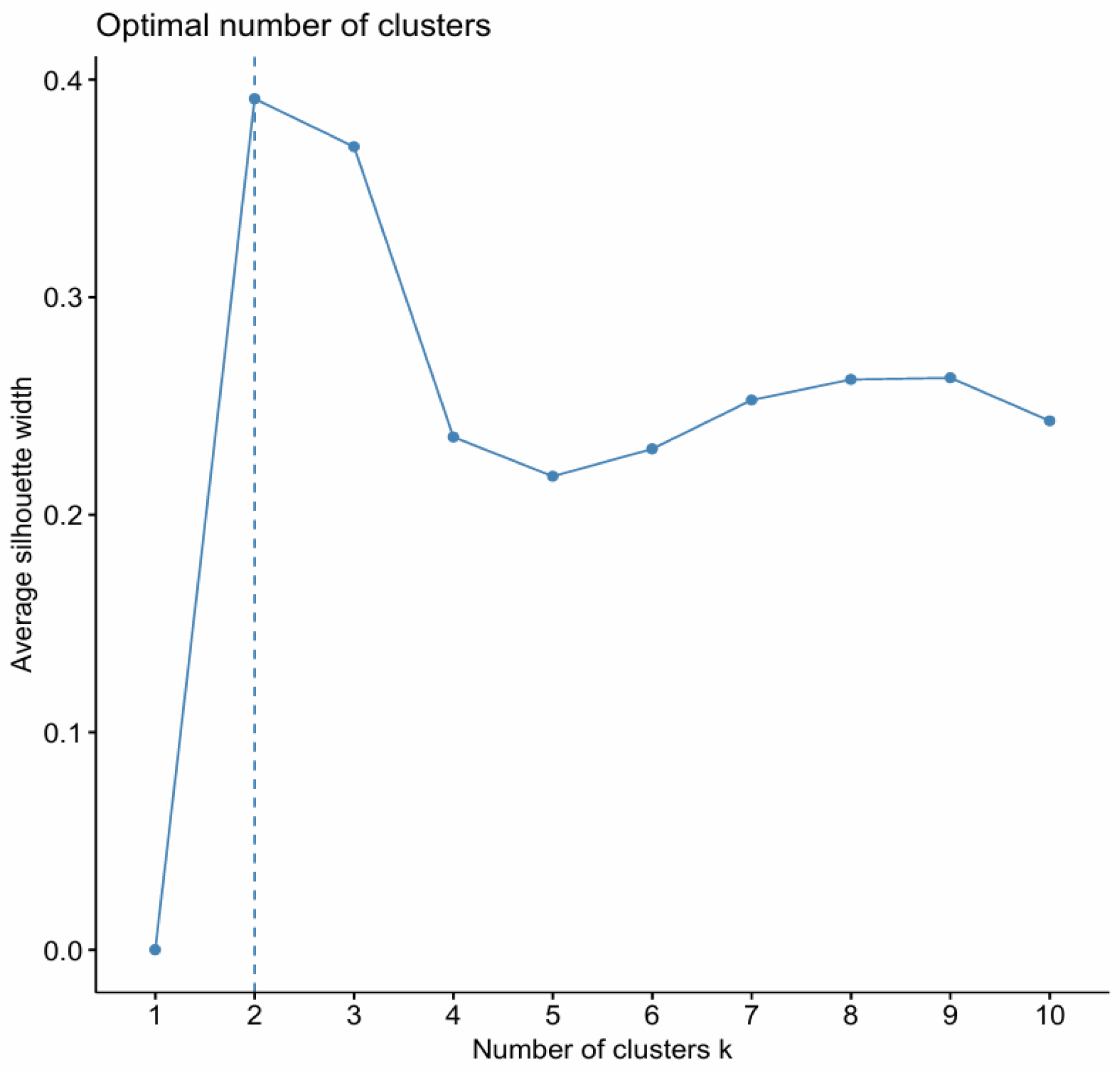
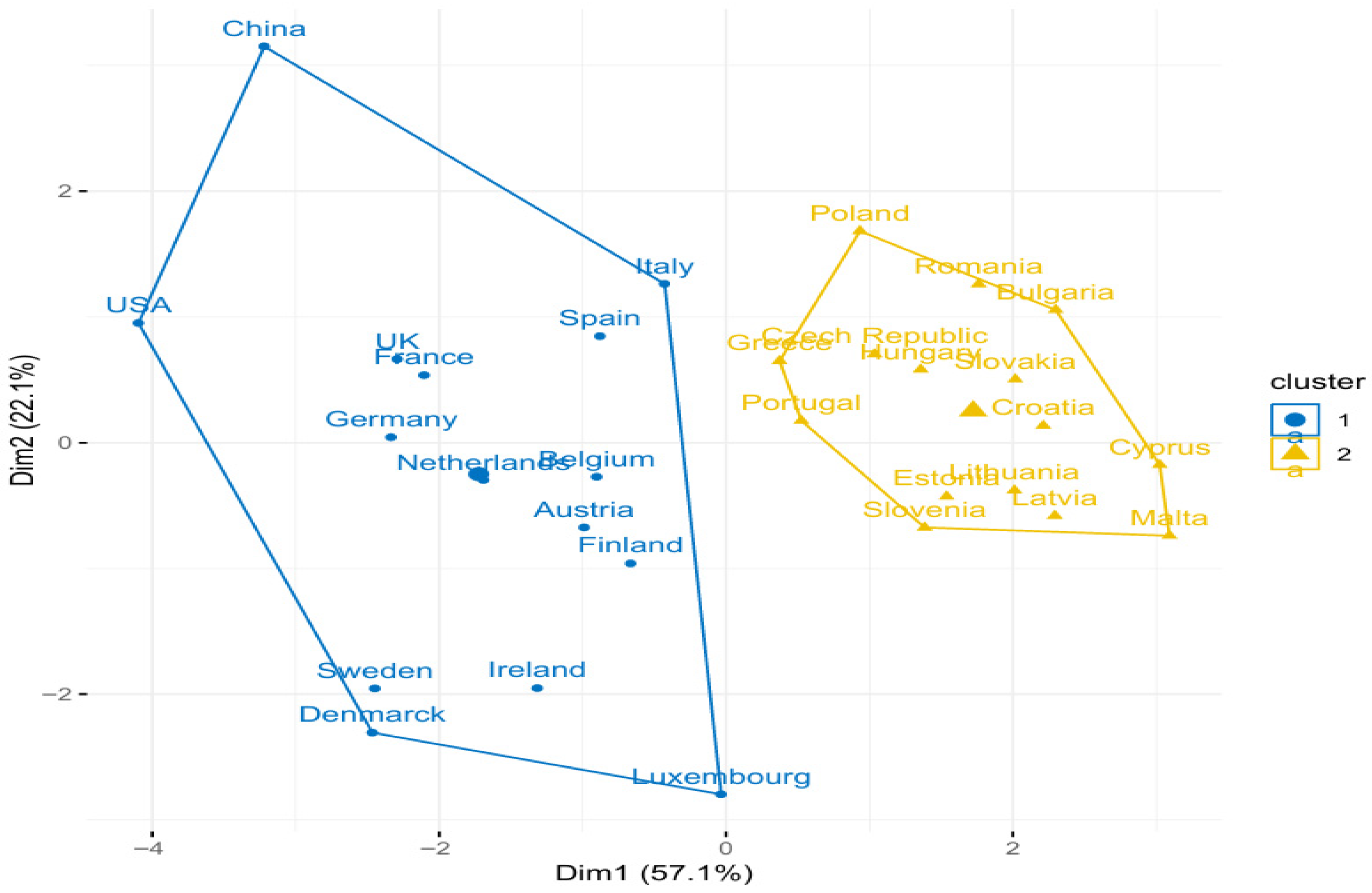
| Category | Variable | Symbol | Definition |
|---|---|---|---|
| Renewable energy—explained variables | Renewable energy production | Ln.RP | Terawatt-hours of energy generated from renewable sources. Used as natural logarithm of renewable energy production |
| Renewable energy consumption | RC | Share of renewable energy consumption | |
| Artificial intelligence—explanatory variables | AI investments | AI.Inv | AI investments as percent of GDP |
| AI Readiness Score | AI.RS | An index for AI engagement | |
| AI-related projects | AI.RP | Number of AI-related projects | |
| Control variables | CO2 emissions | Ln.CO | Million tons of carbon dioxide emissions, used as a natural logarithm |
| GDP per capita (USD) | GDP | Gross domestic product per capita |
| Ln.RP | RC | AI.Inv | AI.RS | AI.RP | Ln.CO | GDP | |
|---|---|---|---|---|---|---|---|
| Valid | 120 | 120 | 120 | 120 | 120 | 120 | 120 |
| Median | 3.199 | 26.600 | 0.900 | 72.850 | 48.500 | 3.816 | 30,486 |
| Mean | 3.249 | 29.780 | 0.965 | 73.125 | 55.700 | 4.163 | 39,171 |
| Std. Deviation | 1.692 | 11.891 | 0.415 | 8.366 | 27.635 | 1.866 | 26,435 |
| Skewness | 0.473 | 1.077 | 0.682 | 0.041 | 0.205 | 0.788 | 1.632 |
| Kurtosis | 0.142 | 0.885 | 0.250 | −1.271 | −1.408 | 0.874 | 2.943 |
| Minim | 0.095 | 11.800 | 0.050 | 58.300 | 15.000 | 0.531 | 10,123 |
| Maxim | 7.775 | 63.600 | 2.200 | 88.700 | 104.000 | 9.366 | 134,560 |
| Model | Min | 1st Qu. | Median | 3rd Qu. | Max |
|---|---|---|---|---|---|
| Ln.RP_model_orig | −1.4746 | −0.4367 | 0.0497 | 0.4581 | 2.6465 |
| Ln.RP_model_std | −0.8714 | −0.2576 | 0.0295 | 0.2716 | 1.5674 |
| RC_model_orig | −20.200 | −5.4560 | −0.0947 | 5.3764 | 21.5399 |
| RC_model_std | −1.6987 | −0.4588 | −0.0079 | 0.4521 | 1.8114 |
| (Intercept) | AI.Inv | AI.RS | AI.RP | Ln.CO | GDP | ||
|---|---|---|---|---|---|---|---|
| Ln.RP_model_orig | Estimate | −1.944 | 1.102 | 2.838 × 10−2 | 1.485 × 10−2 | 4.901 × 10−1 | −2.141 × 10−5 |
| Std. Error | 8.609 × 10−1 | 3.149 × 10−1 | 1.449 × 10−2 | 2.135 × 10−3 | 4.875 × 10−2 | 2.788 × 10−6 | |
| t value | −2.258 | 3.501 | 1.959 | 6.952 | 10.054 | −7.681 | |
| Pr(>|t|) | 0.0258 * | 0.0006 *** | 0.0525 | 2.38 × 10−10 *** | <2 × 10−16 *** | 5.96 × 10−12 *** | |
| Ln.RP_model_std | Estimate | −0.0149 | 0.2690 | 0.1418 | 0.2424 | 0.5418 | −0.3348 |
| Std. Error | 0.0632 | 0.0882 | 0.0855 | 0.0349 | 0.0613 | 0.0446 | |
| t value | −0.412 | 3.501 | 1.659 | 6.952 | 10.054 | −7.681 | |
| Pr(>|t|) | 0.0258 * | 0.0006 *** | 0.0525 | 2.38 × 10−10 *** | <2 × 10−16 *** | 5.96 × 10−12 *** | |
| RC_model_orig | Estimate | −3.470 × 101 | 1.284 × 101 | 1.196 | −3.991 × 10−3 | −5.789 | −2.932 × 10−4 |
| Std. Error | 1.829 × 101 | 4.996 | 3.054 × 10−1 | 7.221 × 10−2 | 1.288 | 6.883 × 10−5 | |
| t value | −1.897 | 2.570 | 3.918 | −0.055 | −4.495 | −4.260 | |
| Pr(>|t|) | 0.0603 | 0.0114 * | 0.0001 *** | 0.9560 | 1.68 × 10−5 *** | 4.23 × 10−5 *** | |
| RC_model_std | Estimate | −0.0338 | 0.4480 | 0.8417 | −0.0092 | −0.9086 | −0.6517 |
| Std. Error | 0.1488 | 0.1743 | 0.2148 | 0.1678 | 0.2021 | 0.1530 | |
| t value | −0.227 | 2.570 | 3.918 | −0.055 | −4.495 | −4.260 | |
| Pr(>|t|) | 0.8206 | 0.0114 * | 0.0001 *** | 0.9560 | 1.68 × 10−5 *** | 4.23 × 10−5 *** | |
| Model | Robust Residual Standard Error | Multiple R-Squared | Adjusted R-Squared | Convergence |
|---|---|---|---|---|
| Ln.RP_model_orig | 0.686 | 0.868 | 0.863 | 13 IRWLS iterations |
| Ln.RP_model_std | 0.399 | |||
| RC_model_orig | 6.285 | 0.524 | 0.503 | 40 IRWLS iterations |
| RC_model_std | 0.528 |
| Model | Min | 1st Qu. | Median | Mean | 3rd Qu. | Max |
|---|---|---|---|---|---|---|
| Ln.RP_model_orig | 0.1041 | 0.9057 | 0.9536 | 0.9207 | 0.9842 | 0.9987 |
| Ln.RP_model_std | ||||||
| RC_model_orig | 0.2160 | 0.8091 | 0.9166 | 0.8428 | 0.9737 | 0.9989 |
| RC_model_std | ||||||
| For the Ln.RP models: 6 weights are ~=1. The remaining 114 are summarized as above. For the RC models: 11 weights are ~=1. The remaining 109 are summarized as above. | ||||||
| Model | Shapiro–Wilk | VIF | Breusch–Pagan | |||||||
|---|---|---|---|---|---|---|---|---|---|---|
| W | p-Value | AI.Inv | AI.RS | AI.RP | Ln.CO | GDP | BP | df | p-Value | |
| Ln.RP_model_orig | 0.961 | 0.001 | 5.565 | 6.823 | 3.411 | 2.689 | 2.406 | 11.41 | 5 | 0.043 |
| Ln.RP_model_std | ||||||||||
| RC_model_orig | 0.988 | 0.401 | 5.565 | 6.823 | 3.411 | 2.689 | 2.406 | 26.68 | 5 | 6.581 × 10−5 |
| RC_model_std | ||||||||||
| Variables | Influence (2 = Rank of 3) | Difference (3 = 5–7) | Cluster 1 Mean | Cluster 2 Mean | ||
|---|---|---|---|---|---|---|
| Orig. | Std | Orig. | Std | |||
| 1 | 2 | 3 | 4 | 5 | 6 | 7 |
| Ln.RP | 5 | 1.2293 | 4.3353 | 0.6419 | 2.2550 | −0.5874 |
| RC | 7 | 0.4765 | 34.5266 | 0.3992 | 28.860 | −0.0774 |
| AI.Inv | 3 | 1.5345 | 1.4300 | 1.1198 | 0.7933 | −0.4148 |
| AI.RS | 1 | 1.7532 | 82.5733 | 1.1294 | 67.9067 | −0.6238 |
| AI.RP | 2 | 1.5439 | 80.5333 | 0.8986 | 37.8666 | −0.6453 |
| Ln.CO | 6 | 1.0071 | 5.1221 | 0.5136 | 3.2423 | −0.4935 |
| GDP | 4 | 1.3687 | 59062 | 0.7524 | 22881 | −0.6163 |
Disclaimer/Publisher’s Note: The statements, opinions and data contained in all publications are solely those of the individual author(s) and contributor(s) and not of MDPI and/or the editor(s). MDPI and/or the editor(s) disclaim responsibility for any injury to people or property resulting from any ideas, methods, instructions or products referred to in the content. |
© 2025 by the authors. Licensee MDPI, Basel, Switzerland. This article is an open access article distributed under the terms and conditions of the Creative Commons Attribution (CC BY) license (https://creativecommons.org/licenses/by/4.0/).
Share and Cite
Vasilescu, L.; Sichigea, M.; Sitnikov, C.; Mihai, L.-S. Nexus Between Artificial Intelligence, Renewable Energy, and Economic Development: A Multi-Method Approach. Economies 2025, 13, 271. https://doi.org/10.3390/economies13090271
Vasilescu L, Sichigea M, Sitnikov C, Mihai L-S. Nexus Between Artificial Intelligence, Renewable Energy, and Economic Development: A Multi-Method Approach. Economies. 2025; 13(9):271. https://doi.org/10.3390/economies13090271
Chicago/Turabian StyleVasilescu, Laura, Mirela Sichigea, Cătălina Sitnikov, and Laurențiu-Stelian Mihai. 2025. "Nexus Between Artificial Intelligence, Renewable Energy, and Economic Development: A Multi-Method Approach" Economies 13, no. 9: 271. https://doi.org/10.3390/economies13090271
APA StyleVasilescu, L., Sichigea, M., Sitnikov, C., & Mihai, L.-S. (2025). Nexus Between Artificial Intelligence, Renewable Energy, and Economic Development: A Multi-Method Approach. Economies, 13(9), 271. https://doi.org/10.3390/economies13090271







